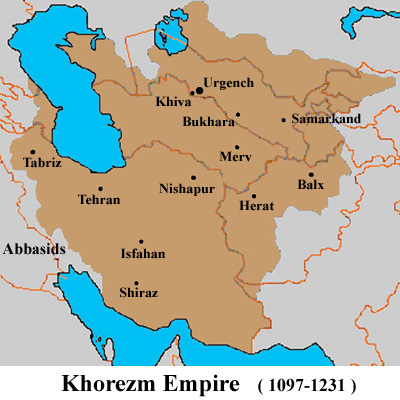“Ancient Khorezm is the Egypt of Central Asia ”-The archeologists
searching the ancient traces of human civilization achieved great
successes through exploring the ancient land of Khorzem. They testified
again that the culture, art and history of Khorezm are entwined with the
development of Central Asia."
------- S.P.Tolstov -------
Geographically Khorezm lies in the east and the south of the Aral sea, on both sides of the lower
reaches of the Oxus (Amudarya) river and around its delta estuary in Turan. It also comprises
the formerly inhabited areas between the Amudarya and the Syrdarya rivers as well as the
southern parts of the arid plateau Ust-yurt, southwest of the Aral sea. Politically it is within
modern day Uzbekistan and constituted a great portion of the ancient Great Silk Road.
The name Khorezm appears in the Avesto, a Zaroastrian religious text, which illustrates the
course of events in Eastern Iran and Central Asia, during which time the society comprised of
different classes of economic disparity. Avesto informs the functions of clergies, army, farmers,
craftsmen, and slaves altogether which formed the first statehood. The events in Avesto occurred
in a land “Arianam Vayja” as the translation confirmed by scientists as Great Khorezm.
 This empire included Praurata (Parfiya), Mouru (Marv), Gava (Sagdiana), and Khveyrezm
(Khorezm).
This empire included Praurata (Parfiya), Mouru (Marv), Gava (Sagdiana), and Khveyrezm
(Khorezm).
So the first statehood developed in Central Asia in the first millennium B.C. Bactria in the IX-
VIII century B.C and in the lower reaches, south of the Aral sea (Northwest of Uzbekistan, North
west of Turkmanistan). Khorezm developed in the VI-VI century B.C. as kingdoms. Bactria and
Khorezm shared frontiers in the middle Amudarya river delta. The first artificial irrigation
construction in Khorezm dates back to the VI-V century B.C. Population was mainly occupied
with agriculture in the villages, and craftsmanship and trade in urban areas.
The archeological excavation confirms that Khorezmians were not only occupied with trade and agriculture but also with science. Khorezmians had sophisticated knowledge of astronomy
and mathematics. They invented angle measuring equipments and used them in their scientific
researches. Astronomic and many natural sciences developed in ancient Khorezm.
The constructions of such equipment survived until this day.
One of these constructions and cultural heritage of Khorezm is
Koykyrilgan Kala. It’s located few kilometers north of the Amudarya
river. The construction dates back to the IV century B.C. The fortress
functioned as a burial-ground for the rulers as well as observatory for
astronomic studies. During the excavation the archeologists found
another interesting document that supposed to be the calendar of
Khorezmians dating back to the III century A.D.
The Khorezmians, for instance, based their prosperity exclusively on
their trade with the Turks, and became chief representatives of the merchant class throughout the country, especially in Khorasan.
 They could be found in considerable numbers in every city
of Khorasan, distinguishable from the local inhabitants by the high fur caps which are worn in
present-day Khorezm. The development of material prosperity was accompanied, not
coincidentally, by that of intellectual pursuits. Almost every teacher at that time could number
some Khorzmians among his disciples. This stands in direct relation to the high level of learning
in Khorezm itself, particularly in Kath and Guganj, at the end of the tenth and beginning of the
eleventh centuries.
They could be found in considerable numbers in every city
of Khorasan, distinguishable from the local inhabitants by the high fur caps which are worn in
present-day Khorezm. The development of material prosperity was accompanied, not
coincidentally, by that of intellectual pursuits. Almost every teacher at that time could number
some Khorzmians among his disciples. This stands in direct relation to the high level of learning
in Khorezm itself, particularly in Kath and Guganj, at the end of the tenth and beginning of the
eleventh centuries.
Khorezm was one of most important lands in Central Asia with its commercial, political, and
cultural development from the VI century B.C until the XIX century A.D. Thanks Khorezm’s
strategic location on the Great Silk road from Iran to India, it actively participated in fostering
relations among various cultures and kingdoms. Therefore traders, craftsmen, scientists and
architects visited here as an important destination. So the Great Silk Road was not merely a
caravan trade route but it also played an instrumental role in the development of civilization of
Central Asia.